Allison Bruning's Blog, page 25
April 9, 2014
#AtoZChallenge: H is for His story, Her story, #History
 H is for His story, Her story, History
H is for His story, Her story, HistoryHistory can be a fascinating subject to study. Many times when someone thinks of history they think it's a dull subject filled with too many dates and facts. But if you look beyond those dates and facts you would find fascinating stories and interesting people.
The history we learn in school is a great foundation but not everything you learn in your history books is true. One thing you have to consider when reading a history book is who the author is. Was the author male or female? What race were they? What cultural group did they belong to?
Take for instance the Civil War.
I grew up in Ohio which is a Northern State. When I was a child I learned all about why the North went to war and why we won the war. I didn't learn that much about the South except that they were slave holding states that wanted to keep slavery. Ohio has always been a free state and a progressive state as well. So because my education was in Ohio I learned Ohio's side of the story. It wasn't until my mom and I moved to Texas that I was exposed to the Southerner's side of the Civil War. I learned in Texas that the Southern states fought to maintain slavery because slaves were an economical commodity that the south needed in order to maintain their agricultural businesses. But slavery wasn't the only reason they went to war. They went to war because they didn't want the Federal government to dictate how their states should operate. When you look at it from their point of view it makes sense. What works for the North wouldn't, as still doesn't, work for the South because those two areas of the United States are very different.

History is written by the winners. What does that mean? That means the history you learn is always
written by the dominant cultural group of that time. The problem is when you depend upon learning history through one group and not your own you run the risk of assimilating into the other culture. We see this all the time the United States. Take for example the Native Americans. Most of what we know about Native Americans has been passed down to use from the white side not the Native Americans. Tribal schools are federally operated although they lie on reservations. As the generations passed tribal elders have passed down their cultural heritage. Children have had struggle with their own cultural identity because Native Americans hold dual citizenship - their tribe and United States of America. The current generation has started to abandon their tribal ways and take up the American white culture. What was started by our ancestors may be finally become a reality - the destruction of the Native American culture - because the native languages and heritage is disappearing form our lands by the actions of the current Native American generation who have assimilated into the white American culture.
When we forget both sides of history we ultimately destroy our own past. We are fated to repeat the same mistakes as our ancestors. I, for one, would rather move forward than repeat the mistakes of my ancestors' past. Wouldn't you?
Published on April 09, 2014 02:56
April 8, 2014
#AtoZChallenge: G is for Genealogy
 G is for Genealogy
I LOVE doing genealogy. I was introduced to genealogy through a 4H project when I was nine years old. I interviewed my grandparents and other members of their generation then took their information and placed what I learned into the family tree. The more I learned about my family the more I wanted to know more. Genealogy isn't just about filling names and dates into a family tree. Sure, that's an important part of it but what I love the best about it are the family stories.
G is for Genealogy
I LOVE doing genealogy. I was introduced to genealogy through a 4H project when I was nine years old. I interviewed my grandparents and other members of their generation then took their information and placed what I learned into the family tree. The more I learned about my family the more I wanted to know more. Genealogy isn't just about filling names and dates into a family tree. Sure, that's an important part of it but what I love the best about it are the family stories.When I started my 4H project my grandparents were excited that I had an interest in learning more about the family. My grandpa Carr challenged me to find his true birthdate. My grandfather had been a toddler when his mother had died in a kitchen fire.
 Grandpa Carr and his siblings were sent to a children's home. When he was placed in the children's home they had recorded his birthdate as Jun 19, 1926. He and his sister argued for years as to the birthday. Aunt Mary had always claimed the year was wrong. She had been born April 19, 1923. There was no way he could have been born in 1926 because their brother, Clarence was older. The brothers were close in age but Aunt Mary was convinced that Grandpa Carr was older then Uncle Clarence. Grandpa Carr argued that he was the youngest of the three children and had insisted the birthdate was correct. Why wouldn't they be right? The adults who had placed them in the home had to know their real birth dates. Didn't that? He argued that all the official records showed he had been born in 1926 and that was good enough for him. But he was missing one thing to verify the accounts from the children's home, his birth certificate. The first year of my genealogical project had searched long and hard to find my grandfather's birth certificate with no luck. I had found his Army records from WWII and they gave me a hint as to what year to look at. I showed them to my grandfather but he argued that the Army had messed up on the records. Aunt Mary wasn't convinced that the military had messed up. I continued my search. The following year I hit the jackpot. I found his birth certificate.
Grandpa Carr and his siblings were sent to a children's home. When he was placed in the children's home they had recorded his birthdate as Jun 19, 1926. He and his sister argued for years as to the birthday. Aunt Mary had always claimed the year was wrong. She had been born April 19, 1923. There was no way he could have been born in 1926 because their brother, Clarence was older. The brothers were close in age but Aunt Mary was convinced that Grandpa Carr was older then Uncle Clarence. Grandpa Carr argued that he was the youngest of the three children and had insisted the birthdate was correct. Why wouldn't they be right? The adults who had placed them in the home had to know their real birth dates. Didn't that? He argued that all the official records showed he had been born in 1926 and that was good enough for him. But he was missing one thing to verify the accounts from the children's home, his birth certificate. The first year of my genealogical project had searched long and hard to find my grandfather's birth certificate with no luck. I had found his Army records from WWII and they gave me a hint as to what year to look at. I showed them to my grandfather but he argued that the Army had messed up on the records. Aunt Mary wasn't convinced that the military had messed up. I continued my search. The following year I hit the jackpot. I found his birth certificate. Freeland Devere Carr was born................
June 23, 1924!
Aunt Mary had won the disagreement. Grandpa Carr didn't like that his birth certificate had shown that date because it made him two years older than what he had been lead to believe his entire life. His tombstone shows his birth year as 1926 but all the other records show 1924.
Published on April 08, 2014 04:42
#AtoZChallenge: G is Genealogy
 G is for Genealogy
I LOVE doing genealogy. I was introduced to genealogy through a 4H project when I was nine years old. I interviewed my grandparents and other members of their generation then took their information and placed what I learned into the family tree. The more I learned about my family the more I wanted to know more. Genealogy isn't just about filling names and dates into a family tree. Sure, that's an important part of it but what I love the best about it are the family stories.
G is for Genealogy
I LOVE doing genealogy. I was introduced to genealogy through a 4H project when I was nine years old. I interviewed my grandparents and other members of their generation then took their information and placed what I learned into the family tree. The more I learned about my family the more I wanted to know more. Genealogy isn't just about filling names and dates into a family tree. Sure, that's an important part of it but what I love the best about it are the family stories.When I started my 4H project my grandparents were excited that I had an interest in learning more about the family. My grandpa Carr challenged me to find his true birthdate. My grandfather had been a toddler when his mother had died in a kitchen fire.
 Grandpa Carr and his siblings were sent to a children's home. When he was placed in the children's home they had recorded his birthdate as Jun 19, 1926. He and his sister argued for years as to the birthday. Aunt Mary had always claimed the year was wrong. She had been born April 19, 1923. There was no way he could have been born in 1926 because their brother, Clarence was older. The brothers were close in age but Aunt Mary was convinced that Grandpa Carr was older then Uncle Clarence. Grandpa Carr argued that he was the youngest of the three children and had insisted the birthdate was correct. Why wouldn't they be right? The adults who had placed them in the home had to know their real birth dates. Didn't that? He argued that all the official records showed he had been born in 1926 and that was good enough for him. But he was missing one thing to verify the accounts from the children's home, his birth certificate. The first year of my genealogical project had searched long and hard to find my grandfather's birth certificate with no luck. I had found his Army records from WWII and they gave me a hint as to what year to look at. I showed them to my grandfather but he argued that the Army had messed up on the records. Aunt Mary wasn't convinced that the military had messed up. I continued my search. The following year I hit the jackpot. I found his birth certificate.
Grandpa Carr and his siblings were sent to a children's home. When he was placed in the children's home they had recorded his birthdate as Jun 19, 1926. He and his sister argued for years as to the birthday. Aunt Mary had always claimed the year was wrong. She had been born April 19, 1923. There was no way he could have been born in 1926 because their brother, Clarence was older. The brothers were close in age but Aunt Mary was convinced that Grandpa Carr was older then Uncle Clarence. Grandpa Carr argued that he was the youngest of the three children and had insisted the birthdate was correct. Why wouldn't they be right? The adults who had placed them in the home had to know their real birth dates. Didn't that? He argued that all the official records showed he had been born in 1926 and that was good enough for him. But he was missing one thing to verify the accounts from the children's home, his birth certificate. The first year of my genealogical project had searched long and hard to find my grandfather's birth certificate with no luck. I had found his Army records from WWII and they gave me a hint as to what year to look at. I showed them to my grandfather but he argued that the Army had messed up on the records. Aunt Mary wasn't convinced that the military had messed up. I continued my search. The following year I hit the jackpot. I found his birth certificate. Freeland Devere Carr was born................
June 23, 1924!
Aunt Mary had won the disagreement. Grandpa Carr didn't like that his birth certificate had shown that date because it made him two years older than what he had been lead to believe his entire life. His tombstone shows his birth year as 1926 but all the other records show 1924.
Published on April 08, 2014 04:42
#Ireland #Myths and #Legends: Bo-Finn, Bo-Ruadh, and Bo-Dhu #farming #Irish #whitecow
 Welcome back to my series on Irish History and Legends. Last week, we moved into the Neolithic Age when farming came to Ireland from England. Farming has always been important to Irish culture since it arrived to the Ireland. There are several myths and legends that deal with farmers. Today I am going to turn my blog over to a text that was written in the book Ancient Legends, Mystic Charms, and Superstitions of Ireland by Lady Francesca Wilde in 1888. Lady Wilde's book is a great read for anyone who is interested in Irish culture.
Welcome back to my series on Irish History and Legends. Last week, we moved into the Neolithic Age when farming came to Ireland from England. Farming has always been important to Irish culture since it arrived to the Ireland. There are several myths and legends that deal with farmers. Today I am going to turn my blog over to a text that was written in the book Ancient Legends, Mystic Charms, and Superstitions of Ireland by Lady Francesca Wilde in 1888. Lady Wilde's book is a great read for anyone who is interested in Irish culture.How Cattle Came to Ireland By: Lady Francesca Wilde
The most singular legends of Ireland relate to bulls and cows, and there are hundreds of places all commencing with the word Bo (one of the most ancient words in the Irish language), which recall some mystic or mythical story of a cow, especially of a white heifer, which animal seems to have been an object of the greatest veneration from all antiquity.
In old times there arose one day a maiden from the sea, a beautiful Berooch, or mermaid, and all the people on the Western Coast of Erin gathered round her and wondered at her beauty. And the great chief of the land carried her home to his house, where she was treated like a queen.
And she was very gentle and wise, and after some time she acquired the language, and could talk to the people quite well in their own Irish tongue, to their great delight and wonder. Then she informed them that she had been sent to their country by a great spirit, to announce the arrival in Ireland of the three sacred cows—Bo-Finn, Bo-Ruadh, and Bo-Dhu—the white, the red, and the black cows, who were destined to fill the land with the most splendid cattle, so that the people should never know want while the world lasted.
This was such good news that the people in their delight carried the sea-maiden from house to house in procession, in order that she might tell it herself to every one; and they crowned her with flowers, while the musicians went before her, singing to their harps.
After dwelling with them a little longer she asked to be taken back to the sea, for she had grown sad at being away so long from her own kindred. So, on May Eve, a great crowd accompanied her down to the strand, where she took leave of them, telling them that on that day year they should all assemble at the same place to await the arrival of the three cows. Then she plunged into the sea and was seen no more.
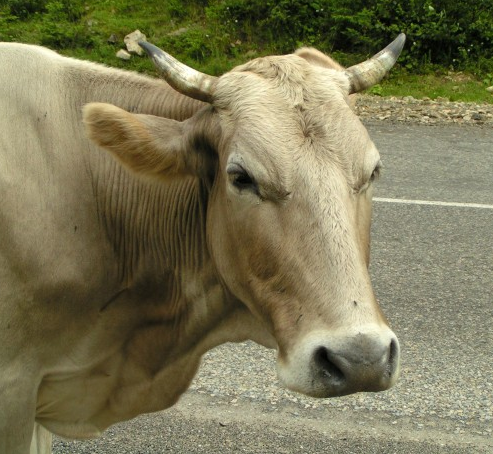 However, on that day year all the people of Ireland assembled on the shore to watch, as they had been directed by the beautiful sea-maiden; and all the high cliffs and all the rocks were covered with anxious spectators from the early dawn. Nor did they wait in vain. Exactly at noon the waves were stirred with a mighty commotion, and three cows rose up from the sea—a white, a red, and a black—all beautiful to behold, with sleek skins, large soft eyes, and curved horns, white as ivory. They stood upon the shore for a while, looking around them. Then each one went in a different direction, by three roads; the black went south, the red went north, and the milk-white heifer—the Bo-Finn—crossed the plain of Ireland to the very centre, where stood the king's palace. And every place she passed was named after her, and every well she drank at was called Lough-na-Bo, or Tober-Bo-Finn (the well of the white cow), so her memory remains to this day.
However, on that day year all the people of Ireland assembled on the shore to watch, as they had been directed by the beautiful sea-maiden; and all the high cliffs and all the rocks were covered with anxious spectators from the early dawn. Nor did they wait in vain. Exactly at noon the waves were stirred with a mighty commotion, and three cows rose up from the sea—a white, a red, and a black—all beautiful to behold, with sleek skins, large soft eyes, and curved horns, white as ivory. They stood upon the shore for a while, looking around them. Then each one went in a different direction, by three roads; the black went south, the red went north, and the milk-white heifer—the Bo-Finn—crossed the plain of Ireland to the very centre, where stood the king's palace. And every place she passed was named after her, and every well she drank at was called Lough-na-Bo, or Tober-Bo-Finn (the well of the white cow), so her memory remains to this day.In process of time the white heifer gave birth to twins, a male and female calf, and from them descended a great race, still existing in Ireland; after which the white cow disappeared into a great cave by the sea, the entrance to which no man knows. And there she remains, and will remain, in an enchanted sleep, until the. true king of Eire, the lord of Ireland, shall come to waken her; but the lake near the cave is still known as Lough-na-Bo-banna (the lake of the snow-white cow). Yet some say that it was the king's daughter was carried off by enchantment to the cave, in the form of a cow, and she will never regain her form until she sleeps on the summit of each of the three highest mountains in Ireland; but only the true king of Eire can wake her from her sleep, and bring her to "the rock of the high place," when she will be restored at last to her own beautiful form.
Another legend says that a red-haired woman struck the beautiful Bo-Finn with her staff, and smote her to death; and the roar which the white cow gave in dying was heard throughout the whole of Ireland, and all the people trembled. This is evidently an allegory. The beautiful Bo-Finn—the white cow—is Ireland herself; and the red-haired woman who smote her to death was Queen Elizabeth, "in whose time, after her cruel wars, the cry of the slaughtered people was heard all over the land, and went up to heaven for vengeance against the enemies of Ireland; and the kingdom was shaken as by an earthquake, by the roar of the oppressed against the tyrant."
The path of the white cow across Ireland is marked by small rude stone monuments, still existing. They
 British White Cows
British White CowsMarilyn Peddle
http://bit.ly/1jq2v80show the exact spot where she rested each night, and had her bed, and the adjoining lands have names connected with the tradition—as, "The plain of the Fenian cows;" "The hill of worship;" "The pool of the spotted ox," called after him because he always waited to drink till the white cow came, for they were much attached to each other.
There are also Druid stones at one resting-place, with Ogham marks on them. Some time ago an
endeavour was made to remove and carry off the stones of one of the monuments; but the man who first put a spade in the ground was "struck," and remained bedridden for seven years.
The plain of the death of the Bo-banna (the white cow), where she gave the roar that shook all Ireland is called "the plain of lamentation." It never was tilled, and never will be tilled. The people hold it as a sacred spot, and until recently it was the custom to have dances there every Sunday. But these old usages are rapidly dying out; for though meant originally as mystic ceremonies, yet by degrees they degenerated to such licentious revelry that the wrath of the priesthood fell on them, and they were discontinued.
There is a holy well near "the plain of lamentation," called Tobar-na-Bo (the well of the white cow); and these ancient names, coming down the stream of time from the far-off Pagan era, attest the great antiquity of the legend of the coming to Ireland of the mystic and beautiful Bo-Finn.
Published on April 08, 2014 03:40
April 7, 2014
#AtoZChallenge: F is for Francis Scott Key
 F is for Francis Scott Key
F is for Francis Scott Key
"O, thus be it ever when freeman shall stand,Between their lov’d homes and the war’s desolation;Blest with vic’ry and peace, may the heav’n-rescued landPraise the Pow’r that hath made and preserv’d us as a nation!Then conquer we must, when our cause it is just,And this be our motto: “In God is our trust.”And the star-spangled banner in triumph shall waveO’er the land of the free and the home of the brave!"
This month is National Poetry Month and I thought it would be important to include one of the most important American poets in the A to Z Blog Challenge. The poem above was written in 1815 by the same poet who gave us the words to our national anthem, Francis Scott Key. Every writer is inspired to create their work of art. This video explains the meaning behind the song "The Star Spangled Banner." You'll never sing the song the same way again after you watch this video.
Published on April 07, 2014 09:30
#AtoZChallenge: E is for #English Civil War: For #King OR Country? #England #CivilWar #Monarchy #History
 This past weekend was so busy for my husband and I that I didn't have a chance to post anything. The Author Spotlight will return next weekend. I have also fallen a day behind in the A to Z Blog Challenge so today I'll be posting two historical pieces for you. Let's start with the letter E and in my next post I'll post the letter F entry.
This past weekend was so busy for my husband and I that I didn't have a chance to post anything. The Author Spotlight will return next weekend. I have also fallen a day behind in the A to Z Blog Challenge so today I'll be posting two historical pieces for you. Let's start with the letter E and in my next post I'll post the letter F entry.E is for the English Civil War
The English Civil War occurred from 1642–1651AD and was a very important conflict that had lasting effects upon that country. Although the conflict began in 1642, it's roots lie in the death of Queen Elizabeth I ( I have to admit Queen Elizabeth I is one of my favorite English monarchs. I'll be covering her at a latter time in the A to Z Challenge. She was such an interesting person.) Queen Elizabeth I had decided not to marry because she loved her country so much she didn't want England to fall into the hands of a foreigner. That would have happened if she married because the law stated she would have to pass her rule over to her husband because she was a woman. The only problem with her thinking was that she didn't have heir. Queen Elizabeth had reigned over England since the death of her half sister, Bloody Mary, in 1559. The daughter of King Henry VIII and Anne Boleyn, Elizabeth I had transformed her beloved country from financial ruin to one of the richest and most powerful countries of that time. She had been urged several times by other nobles and her advisors to marry so her heir could continue the legacy her father had begun and she had completed.Queen Elizabeth decided to name her cousin, James Stuart, as heir to her throne. James was the son of Mary, Queen of Scots, and had reigned over Scotland since July 29, 1567. On March 24, 1603, the beloved queen of England and Ireland, Queen Elizabeth died and her cousin was crowned James I was crowned King of England and Ireland on July 25, 1603. His coronation brought the rule of Ireland, Scotland and England under one ruler for the first time in history.
King Charles I Charles was the second son of King James I and his wife, Anne of Denmark. He was born in Edinburgh, Scotland on November 19, 1600. He joined his family in England after his father was crowned King of England and Ireland. Charles spent much of his life in the English courts. He became heir apparent when his older brother died in 1612. Charles father had suffered from arthritis, gout and kidney stones since 1616. He was a heavy drinker and had lost all of his teeth. James had suffered from bouts of severe attacks of arthritis, gout and fainting fits in the early months of 1625. In March of that year, he fell seriously ill with tertian ague and then suffered a stroke. He was left bed bound and unable to visit London. The Duke of Buckingham, a most trusted friend of the family, helped Charles a great deal while his father was ill. Charles and Buckingham had assumed much of the royal responsibilities while King James as was ill and rumors had spread around the realm about the kind of government Charles would have when he ascended the throne. On March 27, 1625 King James I died at Theobalds House after a serious bout of Dysentery. Buckingham had been by his bedside. He was buried on May 7 at Westminster Abbey, just six days after Charles was married by-proxy to the fifteen-year-old French princess Henrietta Maria in front of the doors of the Notre Dame de Paris.
Many commoners were opposed to the union of Charles and Henrietta because they feared Charles would be undermine the official establishment of reformed Church of England and he would lift restrictions on Catholic recusants. Charles believed kings had divine right to rule and he ignored all the concerns of his people. He married Henrietta Maria in person at Canterbury on June 13, 1625. He opened the second installment of Parliament after his wedding in order to forgo any opposition he may have from them concerning his union with the Catholic princess. His union with Henrietta caused much strife with commoners and members of his Parliament because he allowed his wife to openly practice her faith.
Charles was a devout Anglican but had very controversial beliefs about how he should rule over his kingdoms. He was open minded in a time with Protestants and Catholics hated each other. He believed in the divine right of monarchs and ruled England without a Parliament for eleven years. The longer the king reigned the more enemies he created. Eventually war broke out between those who were loyal to the crown and those loyal to Parliament.
Published on April 07, 2014 05:37
E is for #English Civil War: For #King OR Country? #England #CivilWar #Monarchy #History
 This past weekend was so busy for my husband and I that I didn't have a chance to post anything. The Author Spotlight will return next weekend. I have also fallen a day behind in the A to Z Blog Challenge so today I'll be posting two historical pieces for you. Let's start with the letter E and in my next post I'll post the letter F entry.
This past weekend was so busy for my husband and I that I didn't have a chance to post anything. The Author Spotlight will return next weekend. I have also fallen a day behind in the A to Z Blog Challenge so today I'll be posting two historical pieces for you. Let's start with the letter E and in my next post I'll post the letter F entry.E is for the English Civil War
The English Civil War occurred from 1642–1651AD and was a very important conflict that had lasting effects upon that country. Although the conflict began in 1642, it's roots lie in the death of Queen Elizabeth I ( I have to admit Queen Elizabeth I is one of my favorite English monarchs. I'll be covering her at a latter time in the A to Z Challenge. She was such an interesting person.) Queen Elizabeth I had decided not to marry because she loved her country so much she didn't want England to fall into the hands of a foreigner. That would have happened if she married because the law stated she would have to pass her rule over to her husband because she was a woman. The only problem with her thinking was that she didn't have heir. Queen Elizabeth had reigned over England since the death of her half sister, Bloody Mary, in 1559. The daughter of King Henry VIII and Anne Boleyn, Elizabeth I had transformed her beloved country from financial ruin to one of the richest and most powerful countries of that time. She had been urged several times by other nobles and her advisors to marry so her heir could continue the legacy her father had begun and she had completed.Queen Elizabeth decided to name her cousin, James Stuart, as heir to her throne. James was the son of Mary, Queen of Scots, and had reigned over Scotland since July 29, 1567. On March 24, 1603, the beloved queen of England and Ireland, Queen Elizabeth died and her cousin was crowned James I was crowned King of England and Ireland on July 25, 1603. His coronation brought the rule of Ireland, Scotland and England under one ruler for the first time in history.
King Charles I Charles was the second son of King James I and his wife, Anne of Denmark. He was born in Edinburgh, Scotland on November 19, 1600. He joined his family in England after his father was crowned King of England and Ireland. Charles spent much of his life in the English courts. He became heir apparent when his older brother died in 1612. Charles father had suffered from arthritis, gout and kidney stones since 1616. He was a heavy drinker and had lost all of his teeth. James had suffered from bouts of severe attacks of arthritis, gout and fainting fits in the early months of 1625. In March of that year, he fell seriously ill with tertian ague and then suffered a stroke. He was left bed bound and unable to visit London. The Duke of Buckingham, a most trusted friend of the family, helped Charles a great deal while his father was ill. Charles and Buckingham had assumed much of the royal responsibilities while King James as was ill and rumors had spread around the realm about the kind of government Charles would have when he ascended the throne. On March 27, 1625 King James I died at Theobalds House after a serious bout of Dysentery. Buckingham had been by his bedside. He was buried on May 7 at Westminster Abbey, just six days after Charles was married by-proxy to the fifteen-year-old French princess Henrietta Maria in front of the doors of the Notre Dame de Paris.
Many commoners were opposed to the union of Charles and Henrietta because they feared Charles would be undermine the official establishment of reformed Church of England and he would lift restrictions on Catholic recusants. Charles believed kings had divine right to rule and he ignored all the concerns of his people. He married Henrietta Maria in person at Canterbury on June 13, 1625. He opened the second installment of Parliament after his wedding in order to forgo any opposition he may have from them concerning his union with the Catholic princess. His union with Henrietta caused much strife with commoners and members of his Parliament because he allowed his wife to openly practice her faith.
Charles was a devout Anglican but had very controversial beliefs about how he should rule over his kingdoms. He was open minded in a time with Protestants and Catholics hated each other. He believed in the divine right of monarchs and ruled England without a Parliament for eleven years. The longer the king reigned the more enemies he created. Eventually war broke out between those who were loyal to the crown and those loyal to Parliament.
Published on April 07, 2014 05:37
April 4, 2014
#AtoZChallenge D is for DD647: USS Thorn
D is for DD 647:The USS Thorn

The USS Thorn (DD 647) was a Destroyer class battleship that my father served on during World War II. It was commissioned on April 1, 1943 at the Brooklyn Navy Yard, in New York.

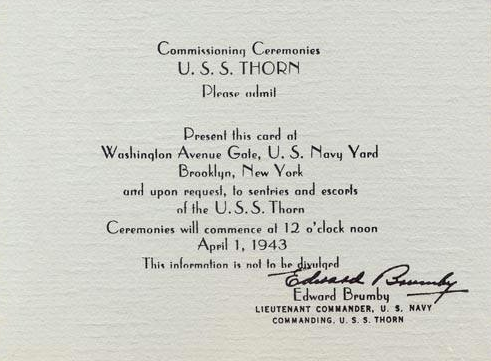
The Thorn joined the Destroyer Squadron 19 (DesRon 19) for service in the Atlantic in May of 1943. The Benson Gleaves - class destroyer served in the Atlantic from May 1943 – January 1944. On January 3, 1944 the Thorn had been docked for only a day when an explosion occurred on the boat and she sank to the bottom of the Ambrose Channel. I remember my dad telling me stories about that day. It wasn't an enemy attack but a malfunction within the ship.
The USS Thorn was repaired and relaunched in February of 1944. It was sent to the Panama Canal where it had been ordered to relieve the DesRon 1 in New Guinea waters. It was delayed to the waters around Guadalcanal and Rendova Islands where it escorted an oiler liner. It finally arrived to the Milne Bay in New Guinea on February 29th where it joined the Destroyer Division 37 for service in the South Pacific. The destroyer also served in the Philipines from October to December of 1944 and was off the coast of Japan in 1945. You can learn more about this amazing ship on Wikipedia and the USS Thorn Association.
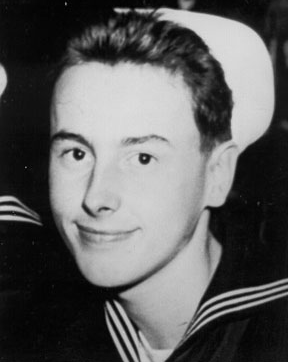 My dad, Roland Irving Bruning
My dad, Roland Irving Bruning
Published on April 04, 2014 04:11
Small #Blessings from #Women with Big #Hearts #Geneaology #Family Treasures

This week my blessings cam from the mail. My husband and I moved to Indianapolis last August, leaving behind our Amish friends in Kentucky. We had been unable to tell them about our move and I feared we would lose contact with them. A few months ago, I asked a mutual friend of ours if she had been out to see them. She told me that family had moved into their new farm and that she had been unable to get our there. She didn't know their address. I was heartbroken. Then I realized that another friend of ours works for the US Postal Service and was friends with the family as well. I contacted Dee and asked her if she knew their new address. She said she didn't but her best friend was the mail carrier for the wife's brother. We are all friends with that family too. She said she would get that address and messaged it to me. The following week she gave me Neil and Maggie's address so I could write to them. I knew Maggie wouldn't be able to write me back because she has four children from the ages of eight to a year. Maggie loves to read letters but rarely writes back. But I knew she would read our letter and pass the information along in the community because we had been friends with the entire community. I asked her in the letter to pass our letter to Nathan and Caroline. She did.
On Thursday, I received a letter from Nathan and Caroline. They were overjoyed at receiving our letter and asked us to stay in touch. I read the letter to my husband and wrote back to the family. I am so glad we can continue to communicate with them. Caroline loves to write letters. She has ten children ages 20 to a year old but that doesn't stop her from writing letters. What a blessings to stay in communication with such dear friends of ours.
My other blessings in the mail arrived the same day. My cousin Jill and I reconnected last year. She is the eldest daughter of my father's brother. I don't know much about my father's family and was sheltered from them for most of my life. My dad died when I was nine years old and I remember very little about his life. I knew bits and pieces, though. I've been searching to learn more about my German side of the family and reconnected with my brother a few years ago. I am the youngest grandchild of August and Johanna Bruning. My dad was 50 when I was born and he already had a son 20 years earlier. My cousins, Jill, Janice and Jeanne are around my brother's age.
Well I received a text from Jill this week and we talked for a bit. She told me she to watch for a package in the mail. She had a few pictures for me. What she sent me melted my heart.
 This is a photo of dad and I.
This is a photo of dad and I.  This is an image of my dad in his diving suit in 1963. He was a sponge diver at Tarpon Springs, Florida and served as a Salvage Diver in World War II.
This is an image of my dad in his diving suit in 1963. He was a sponge diver at Tarpon Springs, Florida and served as a Salvage Diver in World War II. She also sent me a picture of my brother when he was little and a photo of me when I was in pre-school. I had seen those photos before. I loved that she had the the pic of dad and I framed. I showed it to my husband and then placed it on a shelf.
Published on April 04, 2014 03:24
April 3, 2014
#AtoZChallenge: C is for Camp Sherman, #Ohio #military #history
 A to Z Challenge:
C is for Camp Sherman
A to Z Challenge:
C is for Camp Sherman
Welcome back to my blog. Today I'm going to combine my normal Thursday posts about WWI and the A to Z Challenge to tell you about a WWI Camp that plays a pivotal role in my new book, Field of Grace, Camp Sherman. The video below is actual footage of military training at Camp Sherman during WWI.
The First World War (aka: The Great War or WWI) began in Europe on July 28, 1914. President Woodrow Wilson had tried to keep the United States neutral in the conflict. The American people didn't wan to enter into another military conflict. But who could blame them? It had only been forty-nine years since the end of the Civil War. The adults of this generation were the children and the grandchildren of those who fought in the Civil War. The Civil War had left a distaste for war in the mouths of everyone. America's position on remaining neutral during the conflict began to shift when Germany sunk the RMS Lusitania off the coast of Ireland on May 7, 1915. Out of the 1,959 passengers and crew on board only 764 survived. Of those who perished 128 American lives were lost including American publisher and writer, Elbert Green Hubbard. The lost of American lives outraged the American public. Germany's declaration on February 1, 1917 for unrestricted submarine warfare spurred President Wilson into action. He approached a joint session of Congress on April 2, 1917 to request a declaration of war against Germany. He argued the United States should enter the war in order to suspend unrestricted submarine warfare in the North Atlantic and the Mediterranean, and stop Germany's attempts to entice Mexico into an alliance against the United States. Two days later, the Senate agreed to Wilson's terms and on April 6, Congress voted in favor of entering the conflict. With both houses agreeing the declaration of war the United States officially entered World War I. The United States was ill prepared to enter into the conflict but that problem was quickly solved with the establishment of several training facilities throughout the United States. Cities throughout the country placed bids with the war department to have one of these camps built close to them because they recognized the economical incentives the training facilities would bring.
 http://www.chillicotheinfo.com/page/6257/Camp-Sherman-Page-
http://www.chillicotheinfo.com/page/6257/Camp-Sherman-Page-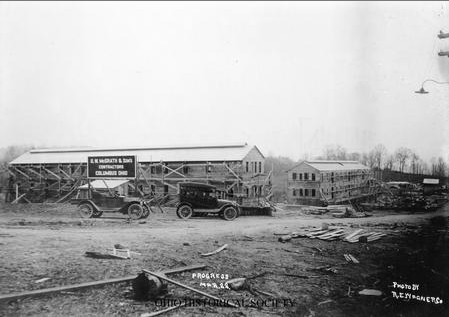 Constructing the barracksOn June 28th, Captain Walter L Gickler and 129 men of Company D, Ohio Engineers arrived at the site and began construction. The number of workers swelled to 300 within two days. Ninety five percent of the camp was finished by the time the first draftees arrived on September 5, 1917. Two days later the Army decided to raise the regiment size at Camp Sherman from 2,000 to 3,600 men. 150 more buildings were constructed bring the camp to the size of 2,000 buildings erected over 1,700 acres of land. The camp swelled Chillicothe's population from 16,000 to 60,000 almost overnight. Camp Sherman was organized like a small city with a library, hospital, farms, and theaters. It also served as one of the POW camps for German soldiers. Yes, that's right. We would capture Germans and ship them overseas to detain them at Camp Sherman. Camp Sherman has such an interesting history. I cannot possibly cover it all.
Constructing the barracksOn June 28th, Captain Walter L Gickler and 129 men of Company D, Ohio Engineers arrived at the site and began construction. The number of workers swelled to 300 within two days. Ninety five percent of the camp was finished by the time the first draftees arrived on September 5, 1917. Two days later the Army decided to raise the regiment size at Camp Sherman from 2,000 to 3,600 men. 150 more buildings were constructed bring the camp to the size of 2,000 buildings erected over 1,700 acres of land. The camp swelled Chillicothe's population from 16,000 to 60,000 almost overnight. Camp Sherman was organized like a small city with a library, hospital, farms, and theaters. It also served as one of the POW camps for German soldiers. Yes, that's right. We would capture Germans and ship them overseas to detain them at Camp Sherman. Camp Sherman has such an interesting history. I cannot possibly cover it all. Here are a few interesting links about Camp Sherman:
Ohio History CentralCamp Sherman. orgRemarkable Ohioand Chillicothe Info
The United States Army closed Camp Sherman in 1920. It used today by the Ohio National Guard as a training facility. Here are some pictures from Camp Sherman. Enjoy!
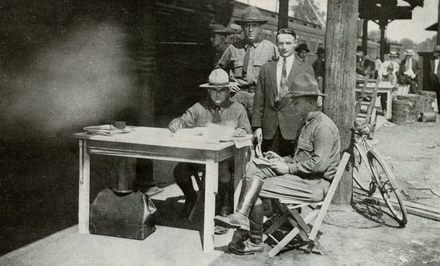 First draftee at Camp Sherman.
First draftee at Camp Sherman.
This one is my favorite. The men at Camp Sherman stood in perfect formation to make the image of President Woodrow Wilson for an ariel shot of the president.
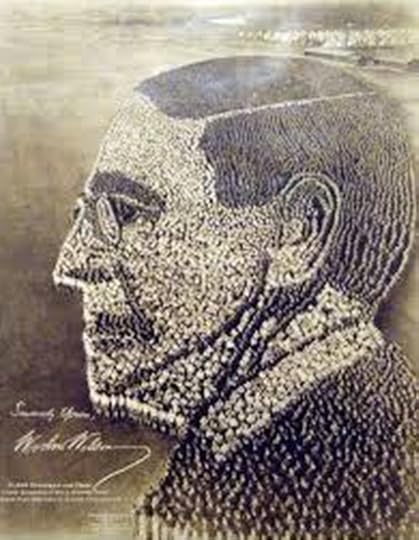
Published on April 03, 2014 04:10



